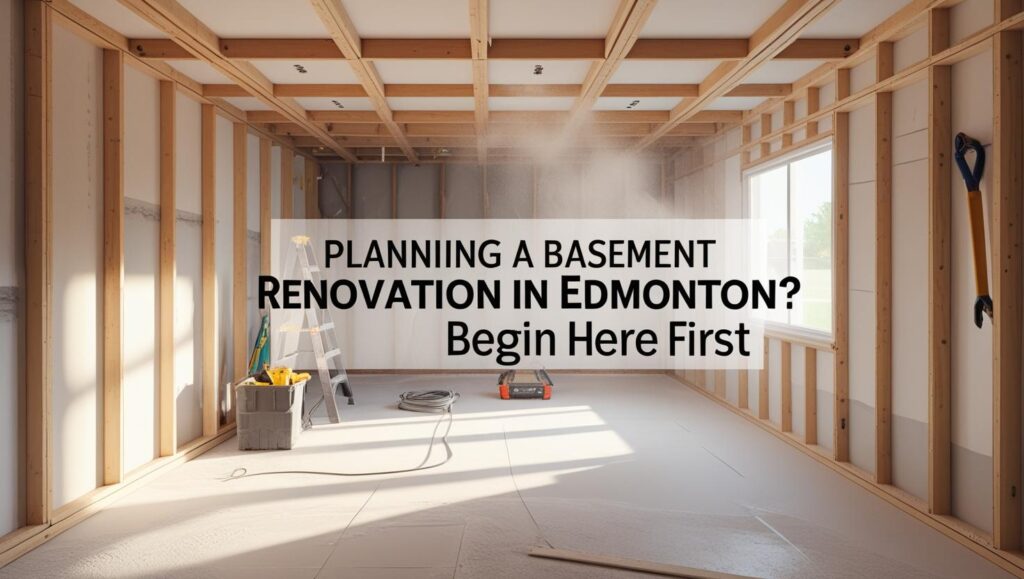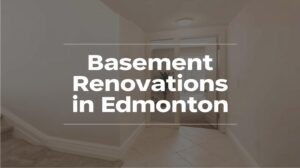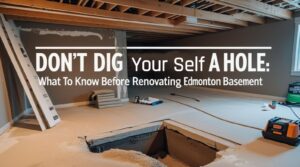Planning a Basement Renovation in Edmonton? Begin Here First
Planning a basement renovation in Edmonton? Begin here first to ensure your project goes smoothly, remains within budget, and adheres to Edmonton regulations. Whether you want to build a cozy family room, a rentable legal suite, or an elegant home office, this guide takes you through the essential steps prior to any renovation or construction.
1. Know Your Why
Before you pick up a hammer or hire a contractor, establish why you are renovating your basement. Do you want to add value to your home for resale, provide space for an expanding family, or earn rent from tenants? Each reason requires a different style of design, space arrangement, and cost.
For instance, a law suite will need more plumbing, soundproofing, and city approval, while a home gym will need less in the way of ventilation and flooring. Making your purpose clear from the start will determine every other choice.
2. Check the Space
Edmonton basements present special conditions with the climate of the city. Pre-design your ideal basement by checking for:
Moisture problems: Search for signs of water damage, odors, or cracks in the foundation.
Ceiling height: Make sure it complies with minimum height standards for habitable space.
Structural elements: Check for any barriers like load-bearing walls, ducts, or low beams.
Getting a home inspector or structural engineer on board can be a good idea to prevent future surprises in terms of expenses.
3. Know Edmonton’s Permit Requirements
One of the most important aspects of basement renovation in Edmonton is being on the proper side of the law. The majority of basement endeavors—particularly those that include plumbing, electrical, or rearrangement modifications—must be permitted. This encompasses completing an unfinished basement or turning it into a secondary suite.
The City of Edmonton would normally need building, plumbing, electrical, and possibly HVAC permits, based on the extent of your renovation. Not getting these permits can result in fines, safety issues, and difficulty when selling your home.
Always double-check area building codes, and perhaps begin your planning process by going through city guidelines or talking to a building inspector.
4. Establish a Realistic Budget
Basement renovation can cost everything from $20,000 for a cosmetic upgrade to more than $100,000 for a fully finished legal suite. Be realistic about your budget and set up a budget that accounts for:
Labor and materials
Permits and inspections
Hidden expenses (always budget 10–20% for surprise expenses)
Furniture and furnishings
Divide your renovation into must-haves and nice-to-haves. This keeps you focused when surprise problems pop up or prices change.
5. Plan the Layout Thoughtfully
The layout of your basement should reflect your goals, but also the existing structure of your home. Since basements often house mechanical systems (like water heaters and furnaces), plan your layout around these elements unless you’re prepared for major rerouting.
Common basement layout options include:
Open-concept entertainment area
Guest or in-law suite
Home gym or yoga studio
Office or creative studio
Secondary rental suite
Use natural light to its fullest by situating bedrooms or living areas close to windows. If your basement is not well lit, think about installing egress windows, which must be installed for bedrooms and enhance overall safety.
6. Insist on Waterproofing and Insulation
Edmonton’s freeze-thaw cycle and precipitation make waterproofing a must component in any basement renovation. Water can destroy finished surfaces, develop mold, and compromise the structure of your home.
Invest in good drainage systems, sump pumps, and sealants. Inside waterproofing techniques such as vapor barriers or water-resistant drywall can also prove effective.
As for insulation, look to spray foam or rigid foam for efficiency. A well-insulated basement will remain warmer during winter, cooler during summer, and lower your energy bill throughout the year.
7. Select Materials That Function Below Grade
Not everything that goes up works well below the ground. Choose moisture-resistant materials like:
Vinyl plank or tile flooring instead of carpet or hardwood
Moisture-resistant drywall (green board)
Paints and sealants specifically made for basements
LED lighting to minimize heat and energy usage
These will better weather humidity and possible water exposure, and your renovation will last longer.
8. Consider Lighting and Ventilation
Basements do not have natural sunlight, so lighting is essential. Include a combination of ambient, task, and accent lighting to provide an inviting and useful space. Dimmable lights should be used to control the mood and low ceilings should be thought of with pot lights.
Ventilation is just as crucial. Edmonton basements can develop musty odors if they are not well-ventilated. Ensure your HVAC system is capable of handling the extra space, or add exhaust fans or energy recovery ventilators (ERVs) to enhance air quality.
9. Don’t Skimp on Design
Functionality matters, but so does style. A basement can’t be too second-rate. Incorporate aspects of your upstairs design—coordinate trim, colors, and flooring—to make it feel like an actual part of your house.
Include personal elements such as feature walls, built-ins, or specialty lighting to take it to the next level. With intelligent design decisions, your basement can be the most well-used area of the house.
10. Plan for the Future
Think ahead. Do your needs differ in five or ten years? If they do, design in some flexibility. For instance, you can cable the area for future technology changes, pre-plumb for an added bathroom someday, or install temporary partitions rather than permanent walls.
A well-planned basement renovation in Edmonton provides long-term value, not merely short-term functionality.
Conclusion
A successful Edmonton basement renovation begins with planning. From establishing your objectives and budget to knowing about permit needs and materials selection, all of the choices you make early on can save you money, time, and aggravation later on.
The basement is full of possibilities—whether you want to create square footage, revenue, or coziness for your home. By using this step-by-step process, you can turn an unused, gloomy space into a bright and usable room that improves your lifestyle and property value.
Whether you’re prepared to roll up your sleeves or hire professionals, the process begins with planning smart. A good renovation starts with a strong foundation—literally and figuratively.





